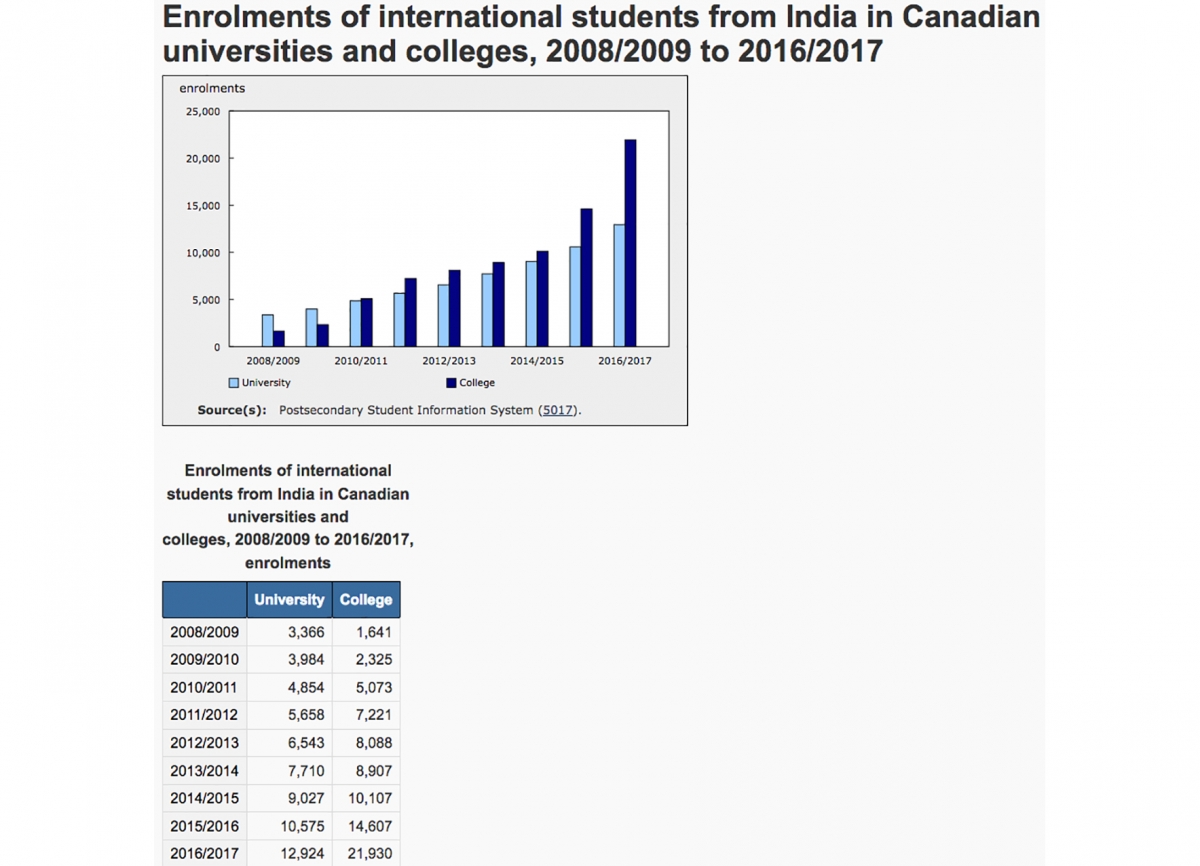
Some interest data – providing a “snapshot” of postsecondary education demographics in Canada at this moment in time – was recently published by Statistics Canada:
Enrolments in Canadian public colleges and universities totalled 2,048,574 in 2016-17, up 1.3 percent (26,811 students) from the previous academic year. Enrolments of international students rose by 11.7 percent (25,581), largely accounting for the increase in overall enrolments. Meanwhile, the number of Canadian students was virtually unchanged (up by 300 students).
The number of international students enrolled in Canadian postsecondary institutions has been on the rise for two decades, with their numbers increasing at a higher rate than that of Canadian students in recent years. International students totalled 244,842 in 2016-17, representing 12.0 percent of overall enrolments.
Increases in international student enrolments in Canada are observed due to a variety of factors, including programs and policies put in place to increase their numbers, the quality of postsecondary education, and the appeal of Canada as a study destination.
While China remained the top country of citizenship for international students in 2016-17, most of the gains in enrolments of international students from 2015-16 to 2016-17 were a result of the growing number of students from India, up 38.4 percent (9,672 students).
International student enrolments in colleges increased by 14,388 from 2015-16 to 2016-17. International students from India led the increase in college enrolments, up 50.1 percent (or about 7,300). In 2008, the Student Partners Program was put in place to increase approval rates for study permit applications from India destined for Canadian colleges. Meanwhile, the number of international students from India enrolled in colleges increased more than tenfold, from 1,641 in 2008-09 to 21,930 in 2016-17.
In universities, international student enrolments increased by 11,196 from 2015-16 to 2016-17. This was led by higher numbers of international students from both China and India. International students from China increased by 5,211 (8.9 percent) from 2015-16 to 2016-17. The number of international students with Indian citizenship studying in Canadian universities increased by 2,349 (22.2 percent) over the same period.
From 2015-16 to 2016-17, higher enrolments in both universities (up 1.1 percent) and colleges (up 1.7 percent), fed the rise in overall postsecondary numbers.
In 2016-17, university enrolments were up by 14,484 compared with the previous year, and have been increasing for almost two decades. Higher numbers of university students enrolled in mathematics, computer and information sciences (5,142) and architecture, engineering and related technologies (4,149) led the increase in 2016-17.
In colleges, enrolments rose by 12,237 from 2015-16 to 2016-17. Business, management and public administration (6,366) posted the largest gain in college enrolments, followed by mathematics, computer and information sciences (3,444).
Women represented 56.2 percent of enrolments in 2016-17, and continued to outnumber men in most fields of study. Education, and health and related fields represented the two fields of study with the highest proportion of women in 2016-17. Women accounted for 77.0 percent of enrolments in education, and 74.1 percent in health and related fields. In contrast, men accounted for the majority of enrolments in architecture, engineering and related technologies (79.5 percent), and mathematics, computer and information sciences (73.0 percent).
In 2016, 531,633 students received a credential – such as a certificate, diploma or degree – from a public postsecondary institution, up 1.9 percent from a year earlier. This represented the eighth consecutive annual increase.
The number of graduates from colleges rose by 4.9 percent from 2015 to 2016. In contrast, the number of university graduates declined slightly (-0.2 percent) over the same period.
Almost half of the 2016 graduates had successfully completed a degree at the bachelor level or above, with 35.4 percent receiving a bachelor's degree, 11.5 percent graduating with a master's degree, and 1.5 percent obtaining a doctorate.
The number of college students who completed a degree at the bachelor level or above more than doubled since 2010. As a proportion, these students represented 1.7 percent of all college graduates in 2010 and 2.9 percent in 2016.
In 2016, 21.2 percent of graduates received a diploma from a career, technical or professional training program.
Women represented 57.1 percent of all graduates in 2016. They comprised more than half of the graduates at all levels of education, except for the doctoral level, where they comprised 46.5 percent of graduates.







